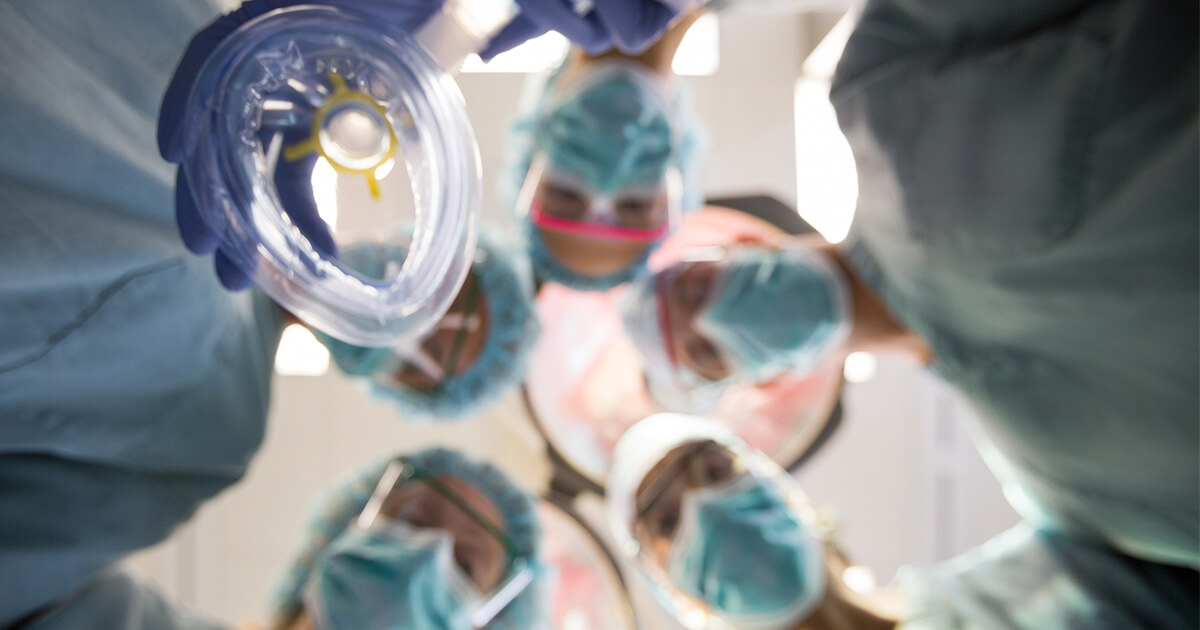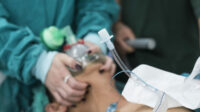Anesthesiologists are medical doctors who specialize in the administration of anesthesia. These specialists work together with surgeons, surgical technologists, and other medical professionals to ensure patients are comfortable and healthy before, during, and after surgical procedures. Like with most specialties, the road to becoming an anesthesiologist is long and challenging to ensure practitioners are prepared to deliver the utmost quality in patient care. What can you expect on your journey towards becoming an anesthesiologist, and how long will the process take?
What is an anesthesiologist?
An anesthesiologist is a Doctor of Medicine (MD) or a Doctor of Osteopathic Medicine (DO) who is specially trained to administer anesthesia on patients both before and during medical procedures and surgeries. Anesthesiologists must be trained in not only anesthetics but also pharmacology, physiology and other areas that relate to administering anesthesia to patients and monitoring them throughout surgery.
While many anesthesiologists work in a surgical setting, some choose to specialize in the treatment and management of chronic pain. In these cases, anesthesiologists work with patients suffering from migraines or other chronic conditions.
How long does it take to become an anesthesiologist?
Most paths to becoming an anesthesiologist take around 12 years to complete, which includes 4 years of an undergraduate program, four years of medical school, 4-5years of residency training in anesthesiology, and typically followed by 1-2 years in a fellowship subspecialty training. Following residency training, candidates can achieve board certification upon passing the Staged exams administered by the American Board of Anesthesiology (ABA).
What exams do you need to take to become an anesthesiologist?
The following are several of the standardized exams aspiring anesthesiologists have to pass during medical school and residency:
MCAT
The Medical College Admission Test (MCAT) is a required exam for those looking to enter medical school. Students must obtain a passing score in all test areas.
USMLE Step 1
Most students take Step 1 at the end of their second year. The following topics are on the USMLE Step 1:
- General Principles 12–16%
- Blood & Lymphoreticular/Immune Systems 7-11%
- Behavioral Health & Nervous Systems/Special Senses 9–13%
- Musculoskeletal, Skin & Subcutaneous Tissue 6-10%
- Cardiovascular System 5-9%
- Respiratory & Renal/Urinary Systems 9-13%
- Gastrointestinal System 5-9%
- Reproductive & Endocrine Systems 9-13%
- Multisystem Processes & Disorders 6-10%
- Biostatistics & Epidemiology/Population Health 4-6%
- Social Sciences: Communication and Interpersonal Skills 6-9%
USMLE Step 2 CK
Most students take the USMLE® Step 2 CK after completing their third year of medical school, immediately after clinical rotations. The USMLE Step 2CK covers the following:
Systems & Processes
- General Principles of Foundational Science: 2-4%
- Immune System: 3-5%
- Blood & Lymphoreticular Systems: 4-6%
- Behavioral Health: 6-8%
- Nervous System & Special Senses: 6-8%
- Musculoskeletal Sys/Skin & Subcutaneous Tissue: 6-10%
- Cardiovascular System: 8-10%
- Respiratory System: 7-9%
- Gastrointestinal System: 7-9%
- Renal & Urinary Systems & Male Reproductive: 4-6%
- Pregnancy, Childbirth, & the Puerperium: 4-6%
- Female Reproductive System & Breast: 4-6%
- Endocrine System: 4-6%
- Multisystem Processes & Disorders: 4-6%
- Biostatistics & Epidemiology/Population Health: 3-5%
- Social Sciences: Legal/Ethical Issues & Professionalism/Systems-based Practice & Patient Safety: 10-15%
Physician Tasks/Competencies
- Patient Care: Diagnosis
- Laboratory/Diagnostic Studies: 13-17%
- Diagnosis: 16-20%
- Prognosis/Outcome: 5-9%
Patient Care: Management
- Maintenance/Disease Prevention: 8-12%
- Pharmacotherapy: 8-12%
- Clinical Interventions: 6-10%
- Mixed Management: 12-16%
Communication/Professionalism: 5-7%
Systems-based Practice/Patient Safety: 5-7%
Practice-based Learning & Improvement: 3-5%
USMLE Step 3
After graduating from medical school, you will sit for Step 3. The USMLE Step 3 covers the following:
- General Principles of Foundational Science 1–3%
- Immune System, Blood & Lymphoreticular System, and Multisystem Processes/Disorders 6–8%
- Behavioral Health 4–6%
- Nervous System & Special Senses 8–10%
- Skin & Subcutaneous Tissue 4–6%
- Musculoskeletal System 5–7%
- Cardiovascular System 9–11%
- Respiratory System 8–10%
- Gastrointestinal System 6–8%
- Renal/Urinary & Male Reproductive Systems 4–6%
- Pregnancy/Childbirth & Female Reproductive System & Breast 7–9%
- Endocrine System 5–7%
- Biostatistics & Epidemiology/Population Health & Interpretation of the Medical Literature 11–13%
- Social Sciences: Communication Skills/Ethics/Patient Safety 7–9%
Following the completion of all three Step exams, are the exams administered by the American Board of Anesthesiology (ABA).
ITE Exams
During residency, you will take the Anesthesiology in Training Exam (ITE) every February. The ITE contains 200 questions, and is considered to be a good preview of what to expect on the BASIC and ADVANCED exams. The ITE covers the following:
Basic Tops in Anesthesiology 50%
- Basic Sciences 12%
- Clinical Sciences 17%
- Organ-Based Basic & Clinical Sciences 19%
- Special Problems or Issues in Anesthesiology 2%
Advanced Topics in Anesthesiology 50%
- Basic Sciences 3%
- Clinical Sciences 5%
- Organ-Based Basic & Clinical Sciences 16%
- Clinical Subspecialties 23%
- Special Problems or Issues in Anesthesiology 3%
Anesthesia BASIC
Residents in their CA-1 year sit for the BASIC exam, which is the first of three Staged exams required to achieve board certification in anesthesiology. The Anesthesia BASIC exam contains 200 multiple choice questions on the following:
- Basic Sciences 24%
- Clinical Sciences 36%
- Organ-Based Basic & Clinical Sciences 37%
- Special Problems or Issues in Anesthesiology 3%
Anesthesia ADVANCED
After completing the BASIC exam and 36 months of satisfactory clinical anesthesiology training, you are eligible to sit for the ADVANCED Exam. The ABA ADVANCED Exam consists of 200 multiple choice questions that cover the following topics:
- Basic Sciences 9%
- Clinical Sciences 10%
- Organ-based Basic & Clinical Sciences 30.5%
- Clinical Subspecialties 44.5%
- Special Problems or Issues in Anesthesiology 6%
- Applied Exam (Oral Boards)
APPLIED Exam
Upon passing the ADVANCED exam, candidates may sit for the APPLIED Exam which includes the traditional Standardized Oral Examination (SOE) and the Objective Structured Clinical Examination (OSCE) component.
The SOE component consists of two 35-minute sessions that assess judgment, organization, and adaptability.
The OSCE component assesses communication, professionalism, and technical skills related to patient care. You will take seven, eight-minute sections, with four-minute breaks between each section.
Fellowship and Subspecialty Exams
Upon obtaining initial certification in Anesthesiology, candidates may enter a fellowship for 1-2 years for subspecialty training. Following the completion of a fellowship, there is a subspecialty exam that must be passed before a candidate is awarded initial certification in their subspecialty.
MOCA®
As a practicing anesthesiologist, your training is a lifelong commitment. To maintain board certification, anesthesiologists must participate in the Maintenance of Certification in Anesthesiology® program known as MOCA®. There are four pieces within MOCA: an active medical license, CME credits, the MOCA Minute, and Quality Improvement Points.
MOCA Minute®
The MOCA Minute® is a longitudinal assessment that requires diplomates to answer 30 timed exam-style questions per calendar quarter for a total of 1200 questions during the 10-year MOCA cycle. Questions cover the following:
- Fundamental Topics in Anesthesiology
- Pharmacology
- Clinical Sciences: Anesthesia Procedures, Methods, and Techniques
- Organ-Based Basic and Clinical Sciences
- Clinical Subspecialties
- Special Problems or Issues in Anesthesiology
- Quality Improvement
- Overview of Anesthesiology Topics
- Critical Care Medicine
- Pain Medicine
- Pediatric Anesthesiology
CME
Anesthesiologists participating in MOCA must earn a total of 250 Continuing Medical Education credits by year 10 of their cycle. Depending on the state, there may be a number of state continuing education requirements for anesthesiologists to complete in order to maintain certification. Take advantage of convenient online CME activities to fulfill these requirements.
The road to becoming an anesthesiologist may be long, but it is worth it to be a part of this rewarding career.




